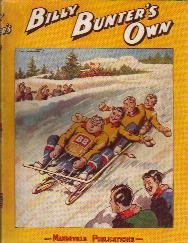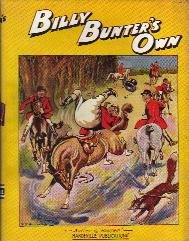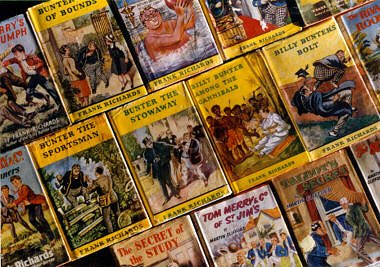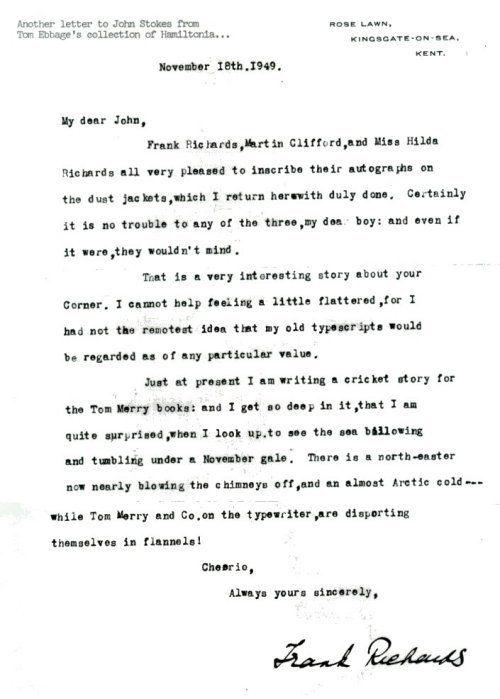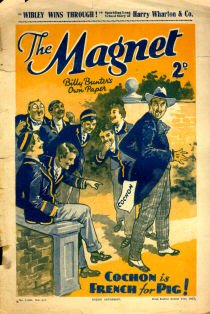| bc |
THE
REMOVE (Our guess, compiled from issues of
the Collectors Digest.)
According to contributor Tommy Keen, the following
members of the Remove were present when Harry Wharton
arrived in issue #1.
Frank Nugent, George Bulstrode, Peter Hazeldene, Dick
Russell, Harold Skinner, Trevor and Treluce, and Billy
Bunter. Bob Cherry arrived in #2, Inky in #6, David
Morgan in #8, Micky Desmond in #15, Smith Minor in #32,
Stott in #35, Wun Lung in #36, David Ogilvy in #43, Mark
Linley and Sidney Snoop in #45, Tom Brown in #86, Smithy
in #119, Alonzo Todd in #125, Fish in #150, Johnny Bull
in #151, Percy Bolsover in #182, Mauly in #184, Dick
Penfold in #194, Monty Newland in #216, Dick Rake in
#258, Oliver Kipps in #268, Peter Todd in #271, Wibley in
#322, Squiff in #343, Delarey (a sub invention) in #432,
Jimmy Vivian in #471, Tom Redwing in #517, Napoleon
Dupont in #540 and Richard Hilary in #559. A total of 38,
but who really knows?RECOMMENDED READING
McCALL'S
GREYFRIARS GUIDE: A Comprehensive Who's Who,What's
What and Where's Where by Peter McCall, Howard Baker
London, 1982
SIX OF THE BEST! David Bathurst, Romansmead Publications,
Chichester, 1994
THE MEN BEHIND BOYS' FICTION W O G Lofts and D J Adley,
Howard Baker, London, 1970
FRANK RICHARDS-THE CHAP BEHIND THE CHUMS Mary Cadogan,
Viking, London, 1988
THE CHARLES HAMILTON MUSEUM Roger Jenkins, London Old
Boys Book Club, Maidstone, undated, post-1961
GREYFRIARS FOR GROWN-UPS Lawrence Sutton, Howard Baker,
London, 1980
THE ROAD TO GREYFRIARS George Samways, Howard Baker,
London, 1984
THE WORLD OF FRANK RICHARDS W O Lofts and D J Adley,
Howard Baker, London, 1975
THE AUTOBIOGRAPHY OF FRANK RICHARDS pub'd by Charles
Skilton, 1952, reprinted in a memorial edition, London,
1962
Visitors write
29/03/2001
I was in Queensland in 1985 and
met aman who claimed to have been one of the models for
Billy Bunter - He said that his father was William Hutton
Mitchell (a presbtyerian Minister) who illustrated Bunter
-this man and his brother would have their cheeks stuffed
with cotton wool -to be used as models for his
illustrations.
Steve answers - The man your chap met
was Alexander Mitchell who lived in Brisbane for many
years. His father was the first Greyfriars artist,
drawing the first 39 or so issues of The Magnet. Hutton
Mitchell (1870-1934) had four sons in all, and all four
were used as models -- with a pillow stuffed down the
trousers to emulate Bunter when necessary. One of the
sons, Capt. Alan Mitchell later wrote for The Gem and a
few other papers before moving with another brother,
Bruce, to Canada. Alan Mitchell died in 1980 but I've not
managed to trace any birth/death dates for the other
brothers, although it seems unlikely they are still
around.
I collect the Magnet volumes detailing
the exploits of Billy Bunter, with a particular
preference for the Howard Baker volumes, and a mild
aversion to the substitute writers collections, although
I admire and respect the integrity of Howard Baker in
keeping these apart from Charles Hamilton's' writing. I
have Cassell and Penguin editions, as well as the
Greyfriars Book Club collection series. I avoid any
editions edited by Kay King, and lament at this lady's'
failure to see the point in retaining the original style,
politically incorrect as that style may be.
In reviewing Richmal Cromptons work, Mary Cadogan noted,
correctly, that Charles Hamilton (Frank Richards) made no
concession to changes in styles and patterns of behavior
in a Magnet period which spanned 33 years, while Richmal
Crompton's characters adopted the vogues and expressions
current to the times in which she wrote. Ms King
obviously saw this as a correctable anomaly. I would
argue that this is the selling point of the stories.
Predictable, formulaic and repetitive, my heart still
beats faster when, on those rare occasions, I find
another to add to my collection.
Callum MacLeod England
Steve: Re printing of
the facsimile editions
The chances are that Baker did have access to the
original copies held by I.P.C. but probably not a full
run.
I believe three sets of the originals were bound, one for
the editor himself, one for the editorial office and one
for "Bear Alley" which was the stock room.
A lot of these went walkabout and it is quite common to
see "Bear Alley" bound copies (in red) for sale
of various old Amalgamated Press papers. Editors took
volumes home, or the stock room copies were taken away so
that editors could research stories for reprinting and
the volumes were never returned... there were lots of
ways the volumes leaked out of Fleetway House over the
years!
Baker was very friendly with Bill Lofts and various other
people connected with the collecting field, so would have
had access to any missing issues via them.
The quickest way to see what wasn't reprinted is George
Beal's book on Baker's Magnet reprints (which I don't
have). His Magnet Companion (which I do have) also
indicates where stories were reprinted, so that's also a
good guide. Somewhere I did have a figure for the total
number, but I can't remember where it is. I know he
reprinted over 1,000 of the 1,683 total. Probably
1,200-1,300.
There are some peculiarities of Frank
Richards' writings that I have never seen comments on.
*He seems to have had an obsession with line 305 of Book
1 of the Aeneid ("At pius Aeneas, per noctem plurima
volvens"). Time and
again in the Bunter stories this line crops up as one
that Bunter makes a mess of construing, or Mr. Quelch
explains to Bob Cherry etc.
*He also seems to have had an obsession with hat-tricks
in cricket. In the first-class game they are rare. Even
in club and school cricket, where wickets tumble more
rapidly, they are seldom seen. But almost every report of
a match at Greyfriars has at least one.
*He seems to have had something against the Geralds and
Gerrys of the world; there are several in his stories,
most notably Gerald Loder the prefect, and Jerry Hawke
the bookie. They are all bad characters!
*He never seems to have made up his mind whether Harold
Skinner's crony was William Stott or Frederick Stott.
Do you know of anyone that could offer enlightening
remarks on any of these observations?
Gerry
(see comment above) Taylor,
Scotland
8/10/2012
Just wanted to say how much I enjoyed the article you wrote about the
Magnet, incorporating the Howard Baker facsimiles, and the Billy Bunter
novels.
I personally enjoy all three ways of reading these stories, and like
you, I feel one of the endearing strengths of them is that the
characters ARE always from the same snapshot in time. Having said that,
I do notice that the world around them does show some signs of change
when early issues are compared to, say, 'Billy Bunter at Butlins', which
has a much more contemporary feel to it, even today. Even though I'm now
a manager in my 50s, married with children, I still like to regularly
read and re-read the stories. In a sometimes unpleasant world, I feel
that there is no better place to be than the universe of Charles
Hamilton!
Probably my favourite is either the Butlins one, or The Phantom of the
Towers, or the Magnet Christmas stories around Wharton Lodge. I'm
currently trying to get a reasonably-priced copy of the Bunter in China
run (any advice welcome), or the Egypt or India stories.
Anyway, once again, well done on the article.
Best wishes,
Jake Nelson
COLLECTORS
REVEAL HOW THEY DISCOVERED BILLY BUNTER and
GREYFRIARS
Steve
Holland
My discovery of Billy Bunter was at the age of 11 when I
moved up from primary school to the local Grammar School.
The importance of the move was two-fold: the Grammar
School was in town, close to the large town-centre
library, the second I'll get to in a minute.
Since the bus time-table
allowed me to spend half an hour every afternoon after
school in the library, I found myself reading a lot of
books that weren't available to me in our little local
library (which was only open a couple of evenings a week,
anyway). For reading matter, I'd often had to rely on my
family, so from the age of 8 I'd been reading whatever
came to hand -- and it was a diverse crop. Since I only
had a children's ticket for the library I was reading
everything from the juvenile section: a few I remember
with huge amounts of nostalgia (although I've not read
them for thirty years) are the Adventure series by Enid
Blyton, the Famous Five and Secret Seven; reprints of the
Hardy Boys and Nancy Drew stories; the Lone Pine
adventures from Malcolm Saville; a smattering of Biggles;
Jennings by Anthony Buckeridge; Swallows and Amazons.
I guess that's a fairly
normal list for a young boy. But at home, when I couldn't
get to the library, I read Agatha Christie (my
grandmother, who lived nearby, was a big fan) and my
dad's books which meant lots of John Creasy (Insp. West,
Department Z, etc.) and James Hadley Chase. The only
thing I didn't read were westerns.
I notice now that most of
the junior books involve young children going off and
having adventures, which is probably what made them so
captivating -- we were not well-off as a family and
holidays usually consisted of day trips down to the
seaside. The only extended (week-long) holidays away from
home we had were also to the coast and usually to dull,
touristy bits of the coast. In stories, children went to
all sorts of interesting places, some of them inland -
the Lone Pine Club members went exploring fog-shrouded
stones on Dartmoor or mountainous parts of Shropshire.
I'd never seen a mountain! (I grew up -- and still live -
in Essex which is just about flat as a pancake.)
Back to the big school and
the big library. There I found the Magnet reprints by
Howard Baker, and devoured all the volumes they had over
a very short period. This would be 1973-74. And I suspect
what I really liked about them was the camaraderie of the
Remove boys, Harry Wharton & Co. I was also a bit on
the chubby side, but never felt any anger towards the
portrayal of Bunter. He was a bit of a weasel; told
outright lies about his forthcoming postal order, stole
food, lied and cheated. Not a very nice boy, and
certainly somebody I didn't identify myself with.
The other boys, Bob
Cherry, Frank Nugent, et al were extremely well-drawn as
characters and displayed some very fine qualities, of
friendship, of loyalty, of honesty... and this is the
second reason that move up to a new school played a part.
Nearly everyone I knew went to the local Secondary School
in the village. I went to the Grammar School where I
didn't know anyone and I was quite painfully shy of
making new friends. Reading about a group of young boys
who really looked out for each other was a vicarious way
of interacting with others and sharing their adventures.
Two other points before I
stop. I never found the books to be old fashioned, even
tho' I knew (from the dates on the covers of the
reprints) that they were forty-year-old stories. It
didn't seem to be a problem, especially when the boys
were on holiday in, say, Egypt. I had no experience of
what Egypt was like, so for all I knew it could still be
exactly as Hamilton described it.
Lastly, being a grammar
schoolboy in the 1970s reading about private schooling in
the 1930s... well, I didn't have a problem with that
either. Again, for all I knew boarding schools were like
that, with studies and teas and football and cricket
matches going on. I imagined that there was probably some
modernisation of lessons, but they seemed to be doing
much the same stuff as we did, including Latin which I
took for three years (without learning much).
Even forty years on, the
stories were still able to hold the attention of a new
generation despite their age. To me, their age didn't
show. What did show was the strength of characterisation
in the writing.#
"Herbert Mauleverer"
(August, 2001) I’ve been a fan of The Magnet for
only a year or so, having been introduced to it by my 80
year old father, and so am quite a newbie. He was a
reader of the comic itself in his childhood who by chance
came across a few Hamilton facsimile editions in a local
library a couple of years ago. Mentioning to me that he
had subsequently tried unsuccessfully to track down any
for purchase I suggested I look on abebooks, made the
mistake of reading one before giving it to him, and the
rest as they say is history! Between us we have now
acquired about a dozen books and are buying them as fast
as we can read and afford more.
My real name is David (I
just thought it would be fun to use a pseudonym), and I
am a 45 year old accountant in the UK (Gt.Yarmouth
actually), married, with two teenage daughters.
Much as I could imagine
myself part of the ‘Famous Six’ I actually
attended Gt.Yarmouth Grammar, as it was called at the
time, which this year celebrates its 450th anniversary
since being founded in 1551. I could not believe the
coincidence therefore when I realised recently that the
date top left on the definitive map of Greyfriars and
surrounding area is also 1551 and is quoted as being when
Edward VI restored the former monastery and opened it as
a school! I wonder if the current Head of my old school
is aware of the illustrious company he is in?
The headmaster in my day
was called Marsden not Locke (and was certainly fond of
the cane), and there were several Quelchs and a couple of
Prouts, but I cannot recall a Bunter in my year. The
teachers were not allowed to administer corporal
punishment, and the worst you could get from a prefect
was lines or a detention. The school building itself was,
like Greyfriars, very old, which helps me imagine some of
the scenes in the books. Reading the Magnet takes me back
to happier days than we seem to have now, when nobody was
really bad (except perhaps Ponsonby), baddies always got
their just desserts, whodunit was obvious from page one,
and everything always ended up happily ever after.
FRANK
RICHARDS' POLITICAL and SOCIAL ATTITUDES
Brian Smith
Some of the remarks about Frank Richards' political and
social attitudes are simplistic. I write as a socialist
who has loved FR for forty years, and won't be changing.
1. Racism. Despite many
foolish epithets, typical of the times, FR seems to have
detested it. There is a splendid passage in a Magnet of
the 1920s where he tears Fishy to shreds for his racist
attitudes. FR deliberately created Hurree Singh, the
cleverest member of the Famous Five, to combat racism
among his readers.
2. Politics. In the early
part of his career FR was interested in socialist ideas,
and his treatment of capitalism in the USA is especially
negative. In later years his main political idea is that
politicians are detestable hypocrites.
3. Snobbery. Arguably, it
is FR's least favourite human characteristic. His waifs
and strays usually make good, unlike his snobs.
4. Women. Again, despite
some foolish language now and again, FR is relatively
fair to suffragists. His strong women aren't simple
termagents: I find the treatment of Miss Bullivant in the
Skip series quite moving.
5. War/violence. The best
illustration of FR's contradictory (but generally
negative) attitude to war is his treatment of Richard
Hilary, with his CO views. This was a remarkable series
to appear in a British boys' magazine in 1918. I
particularly like FR's scornful treatment of warmongering
gents past the age of conscription.
In my view the key to FR's
philosophy, in almost every area, is his hatred of
bullying - and, especially, cruelty to animals. It
explains a lot. If FR had been a dunderheaded Tory he
couldn't have created the complex fiction we admire so
much.
[This article
originally appeared in Billy Bunter Digest Number 342
which is accessible via the link below.]
INDEX of linked page contents
and external links
Any problems, inoperative links or
questions? Please e-mail the page author John .
A
GREYFRIARS MOVIE? Suggested cast and types.
Billy Bunter and The Magnet Bill Nagelkerke's
Paper, 'Would the real Charles Hamilton please stand up:
truth, lies and the recreation of the boarding school
story'.
Restored
to CB&M and corrected 2/2010.
Bunter Books Complete list of
the 38 post-war titles
C. H. CHAPMAN A page of memories,
photos and artwork supplied by the grandson of the famous
'Billy Bunter' artist
Charles Hamilton and the ALL
BLACKS NZ
page
CLUBS AND MAGAZINES
Publications dealing with CH's writings
DISCOVERING BILLY
BUNTER Collectors tell their stories.
Frank Richards Some biographical
details
FRANK RICHARDS' POLITICAL and
SOCIAL ATTITUDES
Friars'
Club - The London-based club. A useful site for
simplified information on all Richards-type publications.
Greyfriars Holiday annual page on
this site.
GREYFRIARS;
a great page from New Zealand with
interactive content (external New Zealand page)
Greyfriars, The
Magnet and Frank Richards
HOWARD BAKER FULL LISTING with ratings
Howard
Baker facsimiles Complete list of the regular
editions, plus occasional reviews of particular volumes
will be found on the The Magnet and
Greyfriars page.
Northern Old Boys Club
(Boys story papers) (external English page)
Recommended Reading Reference
books
RED MAGNET MAGIC! Our page on the
very early issues of 'The Magnet'.
LEONARD SHIELDS Memories of the
great 'Magnet' artist, by his son.
The MAGNET The Story Paper in
which the Greyfriars stories originally appeared.
THE MAGNET Many issues
downloadable as scans (external site.)
The REMOVE Members of your
favourite form (external English page)
The REMOVE Our list
The ROOKWOOD Who's Who
The ST JIM'S Who's Who
Articles of interest
Crickey, it's Christmas!
Alex Kernaghan's tribute to Billy Bunter and The Magnet
in Mayfair (a UK men's magazine of the
late 20th Century), Vol.24, no.12 (special Christmas
issue, undated), p37 .
Back to the Collecting
Books & Magazines index page.
|
bc
|



